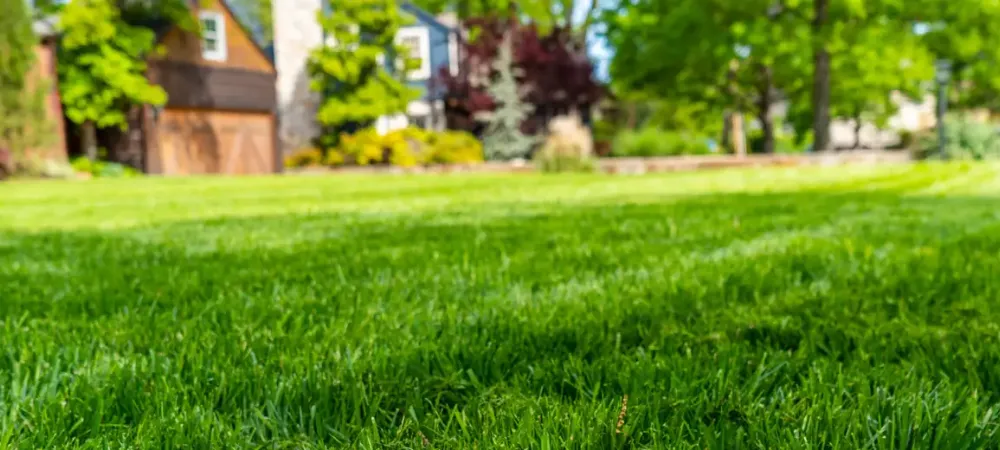Best Grass Types for North Carolina Lawns

North Carolina's landscape is as varied as its weather—from the cooler elevations of the Appalachian Mountains to the hot, humid summers along the coast. These regional differences mean there’s no one-size-fits-all grass for every lawn across the state. Choosing the right grass type depends on your location, soil, sun exposure, and how you use your outdoor space.
Whether you’re in the mountains, the Piedmont, or near the coast, selecting a grass that suits your local climate and lifestyle will lead to a healthier, easier-to-maintain lawn. This guide will help you determine all you need to know for your grass to vibrantly grow.
Warm-Season vs. Cool-Season Grasses
Grasses are generally divided into two categories: warm-season and cool-season.
- Warm-season grasses thrive in hot weather and go dormant during cooler months. They’re ideal for central and eastern North Carolina, where summers are long and winters are mild. These grasses offer excellent heat and drought tolerance but may lose color in the fall and winter.
- Cool-season grasses grow best in cooler temperatures and are more common in the western parts of the state. They remain green longer into the fall and green up earlier in spring but may struggle during hot, dry summers.
Some homeowners in transitional zones (like parts of the Piedmont) opt for blended or mixed-lawn strategies to take advantage of both types and extend lawn health throughout the seasons.
Top Warm-Season Grasses for NC
Bermudagrass
Bermudagrass is one of the most popular warm-season options in North Carolina.
- Best for full sun and holds up well to heavy foot traffic, making it a favorite for active yards and sports fields.
- Requires regular mowing and maintenance to look its best but rewards effort with a thick, durable lawn.
Zoysiagrass
Zoysiagrass grows more slowly than Bermuda but creates a dense, carpet-like lawn that handles both sun and drought well.
- Very tolerant to dry spells and moderate wear.
- Slower to green up in spring, which may be a downside for those wanting early-season color.
Centipedegrass
For a more low-maintenance option, Centipedegrass is ideal—especially in acidic soils, which are common in many NC regions.
- Grows well with minimal fertilization and care.
- Not suited for high-traffic areas, as it doesn't bounce back quickly from wear.
Top Cool-Season Grasses for NC (Mostly Western NC)
Tall Fescue
Tall fescue is a top choice for mountain and foothill regions thanks to its adaptability.
- Thrives in partial shade, and is more drought-tolerant than other cool-season grasses.
- Overseeding in fall helps maintain thickness year-round, especially after summer heat.
Kentucky Bluegrass (in blends)
While not commonly planted on its own, Kentucky bluegrass is often included in blends with fescue for a more lush appearance.
- Offers a fine texture and vibrant color, especially in cooler climates.
- Requires more frequent watering and mowing, and isn’t ideal for drought-prone areas unless mixed.
Factors to Consider When Choosing Grass
The best grass for your lawn isn’t just about region—it’s also about how the space is used and maintained. Before planting or reseeding, consider:
- Sun exposure: Does your lawn get full sun, partial shade, or a mix? Some grasses need six hours or more of direct light each day.
- Soil conditions: Knowing your soil type and pH can help you choose a species that thrives naturally.
- Foot traffic: If kids, pets, or outdoor gatherings are common, go for durable grasses that can recover from wear.
- Maintenance level: Be honest about how much time and effort you're willing to invest—some grasses need frequent mowing and fertilizing, while others are more hands-off.
Tips for Success with Any Grass Type
Regardless of which grass you plant, proper lawn care is key to long-term success. A few general practices will go a long way toward keeping your turf healthy:
- Mow at the correct height for your specific grass type—cutting too low can weaken it over time.
- Water deeply but infrequently, and adjust based on the grass’s growth cycle (more in spring/fall, less in dormancy).
- Aerate annually to reduce soil compaction and improve root growth.
- Fertilize according to the season and your grass’s needs, using the right nutrient balance for optimal performance.
Key Takeaways
North Carolina’s diverse climate means lawn care isn’t a one-size-fits-all process. Choosing the best grass type for your region—and your lifestyle—can save time, reduce frustration, and lead to a better-looking lawn.
No matter where you are in the state, finding a grass that fits your environment and giving it the care it needs to thrive. A little attention to sunlight, soil, and seasonal maintenance can make all the difference.
